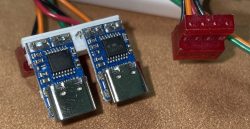Recently I needed a dual voltage power supply to test a newly-arrived PCB, but my usual beast of a lab power supply was temporarily at a client’s site. I had a FNIRSI programmable power supply which would have been perfect, but alas, I had only one. While digging around in my junk box I found several USB-C power-delivery “trigger” boards which I bought for an upcoming project. These seemed almost too small for the task at hand, but after a little research I realized they would work quite well.
The ones I had used the Injoinic IP2721 USB-C power delivery chip, commonly used in many of these boards. Mine had been sold pre-configured for certain output voltages, but they were easy to re-jumper to the voltages I needed, +5 VDC and +20 VDC. The most challenging aspect was physically using them — they are the size of a fingernail. This version had through-hole output pads on 0.1″ centers, so I decided to solder them to the base of a standard MTA pin header. A few crimps later and I was up and running, along with the requisite pair of USB-C cables and power adapters.
For just a few dollars each, these trigger boards are useful to have in your toolbox, both for individual projects and for use in a pinch. We reviewed these modules a couple of years ago, and check out the far more flexible PD Micro that we covered last year.


















yes ok, it’s a nice hack. But it’s not really a fair comparison, now is it?
Testing a PCB with a “power supply” which can whack out 3-5 A changes testing to, “hmm, looks like there was a short, but it’s broken now”.
Still, thanks for this tip, those things look interesting.
*the short was fixed. With incandescent and smoke signalling.
You could put a fuse inline.
Struggling to understand this here.
These modules are not really power supplies, are they?
They are not even voltage regulators, correct?
They are a circuit to tell *another* (smart) power supply (two, in this case) what voltage(s) to supply, right?
So, they are the 2020’s version of a potentiometer on a LM317?
so this chip talks to the USB-C host and ‘asks’ for 5V, 15V, or 20V, and just passes that through. In theory up to 100W, but that’s not usual.
https://www.youtube.com/watch?v=iumAnPiQSj8
Which is *perfectly fine*. If your device ran off 5v you could always stick a usb socket on it and power it from a phone charger, but until recently if it needed any other voltage you had to go hunting for the right power brick or tie up your bench lab supply. These let you convert even those devices that want 9/12/15/20v (or even arbitrary voltages in 0.2v steps if you have PD3.0/PPS) to simply use an existing USB-C charger or powerbank instead.
Use the USB C PD board to feed one of those aliexpress buck/boost PSU modules with CC/CV control and then you have a really versatile solution. I’ll be doing this, replacing the old laptop bricks which I currently (ho ho) use for power.
Struggling to understand if we now have the power supply equivalent of the “could’ve used a 555” comment. If not following the links on the post will answer your questions.
MC: Welcome to the first inaugural, before the lawyers get wind of it, eXXXreme power lashup hackathon. Our two finalists are Tremblin Trev and Shaky Steve, tell us about your triple voltage unit Steve…
Steve: Well Barry as you can see, I just rectiied 115V wall voltage with this bridge I pulled out of dead equipment and chained three HW-411 in series, each dropping 30V in theory, and twiddled the setting until things stopped smoking.
MC: Awesome Steve, Trev?
Trev: As you can see Barry, I’m using the classic series lightbulb power control, with an extra 20 and 60W loose in the socket in parallel with lower values, so I can spin those out and spin the higher drop in if things get hairy. I’m actually taking the voltage off the top half of a 7812, on that Prescott heatsink and sinking the “regulated” 12V through an automotive main beam headlight.
MC: Spectacular.
I thought this was witty. I’ve created many things very similar out of USB electronics I found in the ditch or trash. One thing I’ve made several of: a usb-powered fan. It’s hot here.
Ditch/gutter/snowpilemelt find car chargers are great if they’ve got one of these in https://www.ti.com/product/MC34063A very useful little bugger.
Uh huh. Don’t disparage an egg cracking machine cause you didn’t make the yolk. :-)
Why wouldn’t you use th programmable psu at the high voltage, and a buck converter for the lower voltage?
Does nobody have a USB-PD module that outputs dual 12v + 5v, like was commonly used on standalone “molex” power supplies?
I know I could replicate this using 2USB-PD modules (wasting an extra port on the supply) or using a 5v–>12v boost module (not as compact, not ideal 12v headroom)